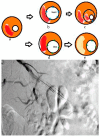Endovascular Drug Delivery
- PMID: 38672722
- PMCID: PMC11051410
- DOI: 10.3390/life14040451
Endovascular Drug Delivery
Abstract
Drug-eluting stents (DES) and balloons revolutionize atherosclerosis treatment by targeting hyperplastic tissue responses through effective local drug delivery strategies. This review examines approved and emerging endovascular devices, discussing drug release mechanisms and their impacts on arterial drug distribution. It emphasizes the crucial role of drug delivery in modern cardiovascular care and highlights how device technologies influence vascular behavior based on lesion morphology. The future holds promise for lesion-specific treatments, particularly in the superficial femoral artery, with recent CE-marked devices showing encouraging results. Exciting strategies and new patents focus on local drug delivery to prevent restenosis, shaping the future of interventional outcomes. In summary, as we navigate the ever-evolving landscape of cardiovascular intervention, it becomes increasingly evident that the future lies in tailoring treatments to the specific characteristics of each lesion. By leveraging cutting-edge technologies and harnessing the potential of localized drug delivery, we stand poised to usher in a new era of precision medicine in vascular intervention.
Keywords: atherosclerosis; drug delivery; endovascular therapy; lesion morphology; lesion-specific treatment.
Conflict of interest statement
The authors declare no conflicts of interest.
Figures


References
-
- Carlyle W.C., McClain J.B., Tzafriri A.R., Bailey L., Zani B.G., Markham P.M., Stanley J.R., Edelmaln E.R. Enhanced drug delivery capabilities from stents coated with absorbable polymer and crystalline drug. J. Control. Release. 2012;162:561–567. doi: 10.1016/j.jconrel.2012.07.004. - DOI - PMC - PubMed
Publication types
LinkOut - more resources
Full Text Sources

